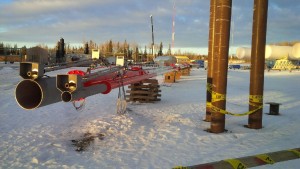In the fall of 2015 Sid Manning, Plumbing and Gas administrator at Alberta Municipal Affairs, spoke to a group of gas Safety Codes Officers about a number of issues of concern regarding gas code enforcement around the Province. One of those issues was the enforcement of the B149.1 and B149.3 codes on the pilot line serving flare stacks on the thousands of industrial plants throughout our province. This was news to many of us in the room, me included, because there has been a belief that the entire flare stack was exempt from these codes. This is partially true because the flare stack is an extension of the process gas system, however the pilot line is using gas as a fuel to light the flare. When a gas such as natural gas or propane is used as a fuel it falls within the scope of the B149 gas codes and subsequently needs to be installed by a licenced gasfitter, the materials have to be certified for use in a gas system as prescribed in the code, and a permit is required so that the installation can be inspected.
If the flare stacks in the picture above are any indication of a typical flare stack installation, the enforcement of the B149 is going to come as something of a revelation to the oil and gas industry. A few short months after listening to Mr. Manning’s instruction, I was on one of our client’s sites where two flare stacks are being prepared to be installed. While the vendor who supplied these flare stacks obviously provided a quality product and attempts to use quality materials; the pilot systems on these flare stacks fall short of meeting the code. The main code issues that were immediately identified are the lack of a product certification and rating plate for the pilot system and a lack of approved materials and components in the manufacturing of the pilot system.
First, the hose used to run up the mast to the pilot control assembly and solenoid is not approved for use in a gas system. The Standard that the hose is certified to is an SAE standard used in the automotive industry. The labelling on the hose states that it is an air brake line and a look at the manufacturer’s specifications for the hose seem to affirm that it is a quality product. However the standard referenced on the hose isn’t one that is recognized by the gas code and as an SCO I don’t have the authority to accept a standard on a product that differs from the code. If the client wanted to use this hose they would need to apply for a variance from the Gas Administrator at Alberta Municipal Affairs, which would likely hold up the project schedule with no guaranty that it would be accepted in the end.
Secondly, still looking at the hose, the supports holding the hose in place are metal gear clamps. With a hose that runs up a mast to upwards of 150 feet in the air, the sides of a metal gear clamp pose a definite risk of cutting into the hose as the wind gusts past, shaking the hose. A different way of supporting the hose is needed, one that can withstand exposure to the environment but not damage the hose.
Lastly, every appliance has to be certified by an approved body authorized by the Standards Council of Canada. Certification is a requirement within the Safety Codes Act and regulations that make it possible for a safety codes officer to inspect the installation of many different products without needing to be an expert in several different fields of engineering and to have the confidence that a product is being put into service in a safe manner and for the use it is intended to serve. In this instance, that certification is likely to come in the form of a field approval by an Inspection Body approved by the Standards Council of Canada.
In the end, none of these code issues will be difficult to remedy but there is going to be an added burden in labour and materials to make these changes in the field. When the manufacturer’s engineers for these flare stacks have had time to compare the standards that the code recognizes and the standards that they’ve been using, higher authorities than me will have to decide if the gas codes are the most suitable standard to meet for the pilot system on a flare stack. It may also be the case that the pilot system on flare stacks should have been considered as “Legacy Equipment” and input into the LEMS program. I’m hopeful that we will be able to work collaboratively with our clients and the manufacturers of this equipment to address any code issues before they leave the manufacturing yard in the future, but I have no option but to enforce the gas code on any new installations that I come across.
By Blake Allen
Senior Gas SCO
Marex Canada Limited

